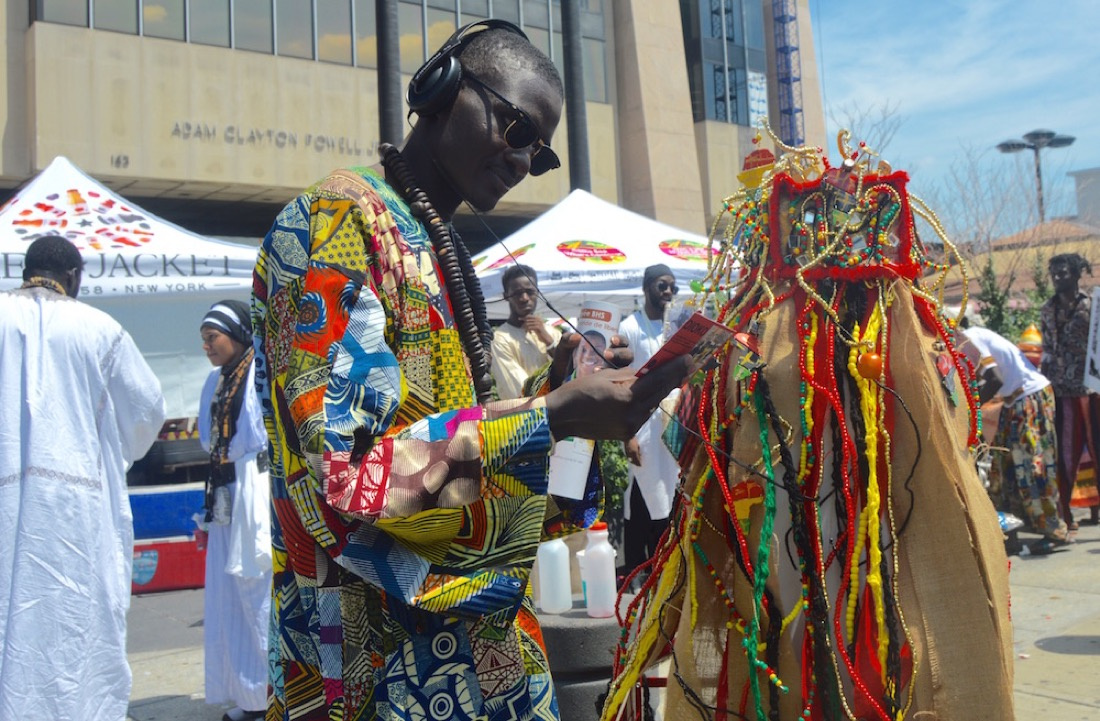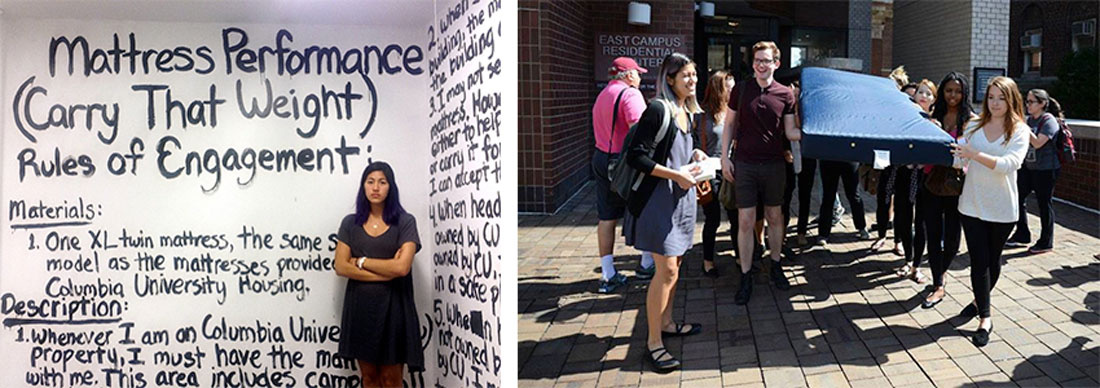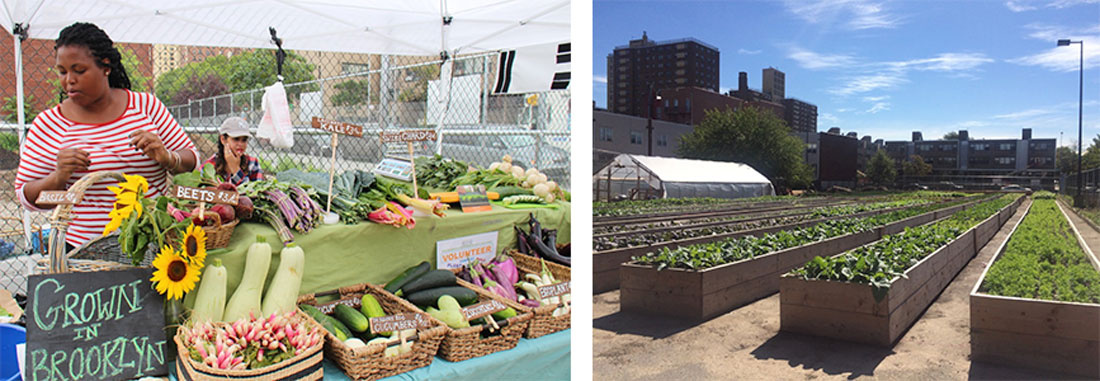The Most Relevant Art Today Is Taking Place Outside the Art World
The Most Relevant Art Today Is Taking Place Outside the Art World
To challenge institutions, we need to look outside of them.

Dioko at Bamba Day Festival with Elvira Clayton, Harlem. Photo courtesy of Elvira Clayton.
There’s a scene in The Simpsons where a middle-aged Abe Simpson—lecturing a teenage Homer about losing touch as one grows old—says, “I used to be with it. Then they changed what ‘it’ was. Now what I’m with isn’t ‘it’ and what’s ‘it’ seems weird and scary to me.” Replace ‘it’ with ‘art’ and you have something fairly close to Michael J. Lewis’s essay on the the demise of art-as-culture, published this July in Commentarymagazine (not something that’s usually on my digital bookshelf, but I digress).
Titled “How Art Became Irrelevant: A chronological survey of the demise of art,” the essay’s central claim is that “while the fine arts can survive a hostile or ignorant public, or even a fanatically prudish one, they cannot long survive an indifferent one. And that is the nature of the present Western response to art, visual and otherwise: indifference.” There are lots of flaws with this argument, as well as its supporting evidence. But besides greatly overstating art’s demise, the conclusion rests heavily on artists who are primarily white men. While Lewis does get some fair shots in about vapid works of spectacle, no matter how you feel about contemporary art, to call an entire swath of culture irrelevant based primarily on those who have been privileged enough to occupy galleries and other institutions (and thus the canon of art history) ignores both the artists who have been historically marginalized from such spaces and the artists who are taking their practices outside of them.

Left: Emma Sulkowicz, “Mattress Performance rules of engagement.” Courtesy of Art in America. Licensed under CC BY 4.0 via Commons. Right: Emma Sulkowicz, Carry That Weight, 2014–1015. The image shows a collective carry, Carry That Weight Together. Licensed under CC BY 4.0 via Commons. Courtesy of Allie Rickard.
In September of 2014, artist and student Emma Sulkowicz began her senior thesis, Mattress Performance (Carry That Weight) (2014-15), a startling piece and ambitious work of endurance that famously involved Sulkowicz carrying a standard Columbia University mattress around campus with her at all times. The burden would quite literally be lifted only after one of two things happened: when the student who Sulkowicz (and subsequently others) accused of raping or sexually assaulting them left or was expelled from the school, or with her own graduation. And so it was that during Columbia University’s graduation ceremony in May, President Lee C. Bollinger turned away as Sulkowicz and four friends carried the mattress across the stage after more than eight long months.
The reaction to the work was far from indifferent. Most visibly, it was heralded by art critics and vitriolically maligned by self-described “men’s rights activists” (this is an actual thing, somehow). Yet one crucial aspect of the piece occurred quietly and without fanfare: the repeated instances when someone on the street grabbed hold of the 50-pound mattress and lent Emma a hand. Her endurance piece compelled many to act in a transformative way—one that spoke both to and beyond her specific case.
Is a call to action displayed in a museum the same as one hauled through the streets?
This participation, Sulkowicz reminded me in a recent conversation, was not explicitly invited by the artist or the work. “I never envisioned people helping me carry it,” she said. She certainly never envisioned that an entire group, “Carrying the Weight Together,” would be set up to coordinate support. In fact, one of the performance’s intrinsic rules—to accept but never ask for help—was partly born out of the expectation of some level of apathy and confusion from the public. “I really thought no one would care,” she said, adding, “but it turned out not to work that way. That rule turned into a call to action.”
Is a call to action displayed in a museum the same as one hauled through the streets? The ability of Carry That Weight to turn viewers into participants is the result of a raw act. The work, as Jerry Saltz put it, is “pure radical vulnerability,” one that would lose something if given the distance of museum’s explanatory wall text. Indeed, Sulkowicz’s work is relevant not only as a thoughtfully conceived piece of performance art, but also as a very public intervention against sexual assault. Though she shies away from being called an activist (“it depletes my agency”), affecting change is an integral part of her practice.
“Rape isn’t going to stop until rapists just stop raping. It’s about really changing the culture,” she told me. “I think that art changes culture. So, in some ways, I think the most direct way to fix the problem is to make art.” And if we ask art to engage the public, especially when it comes to an issue as prevalent as sexual assault, it’s crucial to think about art that’s accessible enough to reach not only those who would choose to walk into a gallery, but a broader public. Still, besides some angry and frankly misogynistic men’s rights activists, many consider Carry That Weight a work of art, albeit one that engaged with activism. It may well appear in a museum show one day.

The Laundromat Project, Field Day 2015: Harlem. Photos by Ray Llanos.
There are, of course, other acts of creativity that do not meet traditional definitions of “fine art” but are no less valuable. If you walk east from Columbia’s Butler Library, down the rocky hills of Morningside Park, and cross a few avenues, you will find a relatively nondescript laundromat, one of some 3,000 in New York. It’s not a gallery, nor a pop-up space, nor the work of an artist who turned an abandoned building into a functioning laundromat. No, it’s a laundromat, but nonetheless one bursting with creativity.
To wit: During the summer months, it hosts workshops by The Laundromat Project, a nonprofit officially started in 2005 that seeks to “amplify the creativity that already exists within communities” through residencies, development programs, and a host of other events, as its executive director Kemi Ilesanmi explained to me. The benefit of hosting public events in laundromats is engaging a diverse group of people. In New York, at least, they are “multi-generational, multi-race, and multi-class spaces,” says Ilesanmi. The type of community engagement fostered by the project isn’t about painting a mural and walking away, but rather commissioning artists who think long and hard about how to engage the communities where the project operates: Harlem, Bedford Stuyvesant, and Hunts Point / Longwood, three neighborhoods primarily made up of people of color with modest incomes and rich histories. Elvira Clayton’s “Dioko,” a “sculptural oral history project,” for example, took place in the much-trafficked hub of African Square on 125th Street and explored Senegalese and African-American communities in West Harlem.
The Laundromat Project attracts people of all ages, many of whom haven’t produced art in years and who might not opt in for a museum experience. “One of the things that makes us stand out is that we meet people where they are,” said Ilesanmi. “It’s not that museums can’t or have never done that. But we actually do it all the time. It’s not a special project.” Ilesanmi notes that the rules governing museums, long conceptualized as something akin to temples, is an alienating experience for many people. “In our opinion everyone is creative, and we remind them of that even when they don’t think that about themselves,” said Ilesanmi, adding, “creative expression is just a part of being human beings.” As we spoke, she talked through the imagined voice of any given person: “I dance, I love music, I love fill in the blank, as a human being in the world. However, I don’t need that validated by, nor do I feel like I have to go into, a formal setting.” Likely because of this inclusive approach, the Laundromat Project has been met with success. The organization was featured at the Creative Time summit and successfully raised $35,000 in 10 days this year. It’s now thinking about how it will adapt and change its program in the future.

Marcus Garvey Apartments (MGA) Brownsville Farmstand (Left) and Farm (Right). Courtesy of Project EATS.
From that Harlem laundromat, if you head southwest about 20 blocks, you’ll arrive at the Frederick Douglass Houses, a 17-building complex home to over 4,500 people. In June of 2012, it was was there that the nonprofit Project EATS helped create a community garden and farm (one of many fostered by the group) out of an unused tennis court just adjacent to a high school, where one can still find it. Broadly, Project EATS works in “partnership with community residents, public schools, and service providers to develop neighborhood resources, skills, and capacity needed for people to have good health and achieve individual and collective goals.” One aspect of that is reclaiming vacant lots, then providing students with the skills necessary to maintain those gardens. As with The Laundromat Project, there’s an emphasis on listening and communicating.
But, Isaac, you may be thinking to yourself if you’ve read this far (thank you!), why are you talking about a sustainable food project? How is that art? Isn’t that social activism? Well: “I don’t distinguish between art and activism in the work I do,” says founder and artist Linda Goode Bryant. “In its essence, I believe art—for the maker and the observer/participant—helps humans grapple with the things we grapple with. Project EATS helps me grapple with creating forms of art that have the capacity to tangibly change the norms and conditions that exist where it occurs.”
The structures by which art is typically presented are not a predetermined, natural way to look at art. They are constructs.
This expansive understanding of art is one that is fundamentally situated within the structures and relationships of the world at large. Indeed, it’s both analytical (thinking about the socioeconomic conditions of how food is made and distributed) and experiential (engaging communities in the ecosystem and inviting them to alter the conditions of the world). So while there is conventional art in Project EATS, as Bryant explains, “each component—from each farm to the exchange and acquisition of food at farm markets, to a video installed within a squirrel hole in a tree growing out of concrete on a subway platform—are part of the overall work of Project EATS’ art.”
Bryant draws on her history as the founder of Just Above Manhattan (JAM), a space she created in 1974. One of the first galleries in the the prestigious East Side gallery district to exhibit black artists—David Hammons, Fred Wilson, and Maren Hassinger among them—JAM was partly an attempt to establish much-needed market parity with white artists. Yet like with Project EATS, Bryant considered the entire enterprise a work of art, not just what occupied the space. “JAM had multiple parts going on at the same time that addressed different aspects of how making and experiencing art is heavily mediated by standards and conventions in how it is presented, who presents it, how it is sold or otherwise acquired,” she wrote me, which in turn impact how “roles—as artists and witnesses—get defined and performed.”
This is a crucial insight: The structures by which art is typically presented are not a predetermined, natural way to look at art. They are constructs (gasp), carrying all the baggage of our society and benefiting those who are usually benefited. So while institutional spaces can be welcome sites for meditation and aren’t antithetical to broader social engagement (Bryant herself will participate in a forthcoming exhibition at Brooklyn Museum to coincide with the Sackler Center’s 10th anniversary), just think: the Guggenheim’s Carrie Mae Weems retrospective was its first dedicated to an African-American woman in its 76-year history—and it happened last year. (Let that sink in—then go read Ashton Cooper’s excellent piece in Hyperallergic about the flawed language we use around such shows when they do occur). When artists operate outside the gallery space, whether because their work functions best there, or because they are forced to, they are both creating valuable art and making the limitations of traditional art institutions visible—physically, historically, and conceptually. Perhaps such work can even change those institutions, those structures of looking. Perhaps it can change society at large. And that’s unceasingly relevant.
—Isaac Kaplan
Comments